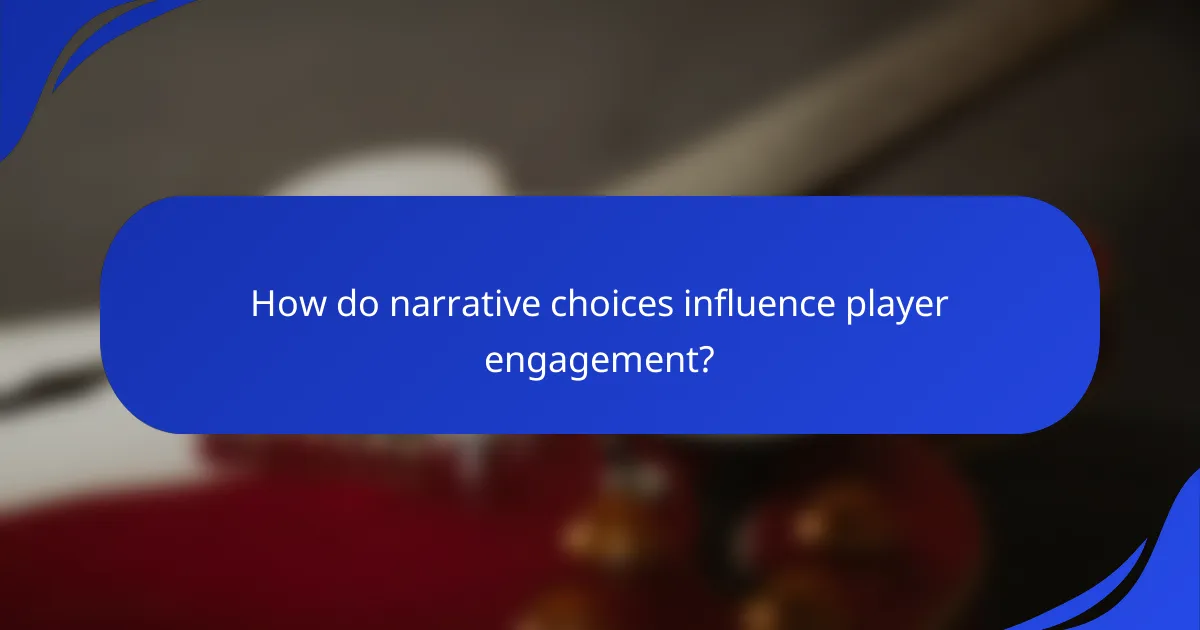Narrative choices play a crucial role in enhancing player engagement by enabling individuals to influence the storyline and outcomes within a game. By incorporating mechanics that promote player agency, games foster a deeper connection to the narrative, allowing players to feel a sense of ownership over their experiences. Titles such as “The Witcher 3: Wild Hunt,” “Life is Strange,” and “Detroit: Become Human” exemplify how impactful decisions can shape the story and elevate emotional investment.

How do narrative choices influence player engagement?
Narrative choices significantly enhance player engagement by allowing individuals to shape their gaming experience. These choices create a sense of agency, making players feel more connected to the story and invested in the outcomes of their decisions.
Emotional connection
Emotional connection arises when players make choices that resonate with their values or experiences. When a game presents morally complex decisions, players often reflect on their own beliefs, fostering deeper emotional ties to the characters and plot. This connection can lead to heightened satisfaction and a memorable gaming experience.
For example, a game that forces players to choose between saving a beloved character or a group of strangers can evoke strong feelings, making the narrative more impactful. The emotional stakes involved in these choices can keep players engaged and invested in the storyline.
Player investment
Player investment is cultivated through meaningful choices that affect the game’s direction and outcomes. When players see the consequences of their decisions reflected in the game world, they are more likely to feel a personal stake in the narrative. This investment can lead to longer play sessions and a desire to explore multiple story paths.
Games that offer branching storylines or multiple endings encourage players to replay them, enhancing their overall investment. For instance, titles like “The Witcher” series or “Mass Effect” allow players to experience different narratives based on their choices, increasing engagement through varied experiences.
Story immersion
Story immersion occurs when players become fully absorbed in the game world, often facilitated by their narrative choices. When players can influence the plot, they are more likely to feel like active participants rather than passive observers. This immersion enhances the overall gaming experience and can lead to a stronger emotional response.
To achieve high levels of immersion, developers should ensure that choices are not only impactful but also seamlessly integrated into the gameplay. For example, interactive dialogue systems that allow players to choose responses can deepen immersion by making conversations feel dynamic and personalized.

What mechanics enhance player agency in games?
Mechanics that enhance player agency in games allow players to make meaningful choices that affect the game’s outcome. These mechanics empower players to shape their experience, fostering a sense of ownership and investment in the narrative.
Branching storylines
Branching storylines provide players with choices that lead to different narrative paths, significantly impacting the game’s progression. This mechanic encourages exploration and replayability, as players can experience various outcomes based on their decisions.
For example, a player might choose to ally with one faction over another, leading to unique quests and endings. Games like “The Witcher” series exemplify this, offering multiple endings based on player choices throughout the story.
Character customization
Character customization allows players to tailor their avatars’ appearance, skills, and abilities, enhancing their connection to the game. This mechanic not only personalizes the experience but also influences gameplay strategies and interactions.
For instance, in RPGs, players might choose different skill sets that affect combat styles or dialogue options. This choice can lead to varied gameplay experiences, encouraging players to experiment with different builds and approaches.
Decision-making impact
Decision-making impact refers to the consequences of player choices on the game world and narrative. This mechanic ensures that players feel their decisions matter, creating a more immersive experience.
In games like “Mass Effect,” choices can lead to significant changes in character relationships and story arcs, affecting not only the immediate gameplay but also long-term outcomes. Players should consider the potential ramifications of their choices, as they can lead to unexpected twists and turns in the narrative.

Which games exemplify effective narrative choices?
Several games stand out for their impactful narrative choices, showcasing how player decisions can shape the story. Titles like “The Witcher 3: Wild Hunt,” “Life is Strange,” and “Detroit: Become Human” illustrate various mechanics that enhance player agency and emotional engagement.
The Witcher 3: Wild Hunt
“The Witcher 3: Wild Hunt” is renowned for its rich storytelling and complex character development. Players navigate a vast open world where choices significantly affect the narrative and character relationships, leading to multiple endings based on decisions made throughout the game.
Key moments often involve moral dilemmas, where players must weigh the consequences of their actions. For example, deciding whether to help a character in distress can lead to unexpected alliances or dire repercussions later in the game.
Life is Strange
“Life is Strange” employs a unique time-rewinding mechanic that allows players to alter past decisions, emphasizing the weight of choices. This feature creates a compelling narrative experience, as players can explore different outcomes and their emotional impacts on characters.
The game focuses on themes of friendship and sacrifice, encouraging players to reflect on their decisions. For instance, choosing to save one character over another can lead to profound changes in the story’s direction, showcasing the ripple effects of player agency.
Detroit: Become Human
“Detroit: Become Human” presents a futuristic narrative where players control multiple android characters, each with their own story arcs influenced by player choices. The game emphasizes the moral implications of artificial intelligence and the quest for freedom, making decisions feel weighty and significant.
Players face critical choices that can lead to drastically different outcomes, such as peaceful protests versus violent uprisings. The branching narratives encourage replayability, allowing players to explore various paths and their consequences in a society grappling with ethical dilemmas.

How to evaluate narrative mechanics in game design?
Evaluating narrative mechanics in game design involves assessing how well the story elements engage players and influence their choices. Key factors include the effectiveness of player feedback systems and the pacing of the story, both of which significantly impact player agency and overall experience.
Player feedback systems
Player feedback systems are crucial for understanding how players interact with the narrative. These systems can include visual cues, audio signals, or in-game notifications that respond to player actions, enhancing immersion and decision-making. Effective feedback should be immediate and clear, allowing players to grasp the consequences of their choices.
Consider implementing a range of feedback types, such as positive reinforcement for desired actions or warnings for potential failures. For instance, a game might use a visual glow effect around an item to indicate its importance after a player interacts with it. This helps players feel more connected to the narrative and encourages exploration.
Story pacing analysis
Story pacing analysis focuses on the timing and rhythm of narrative delivery, which can greatly affect player engagement. A well-paced story balances action, dialogue, and exploration, ensuring players remain invested without feeling rushed or bored. Key considerations include the frequency of plot developments and the duration of quieter moments.
To analyze pacing, map out key story events and their intervals. Aim for a mix of high-stakes moments followed by slower, character-driven scenes. For example, after a climactic battle, a reflective scene can provide players with a moment to process events, enhancing emotional impact. Regularly solicit player feedback to identify pacing issues and adjust accordingly.

What are the emerging trends in narrative design?
Emerging trends in narrative design focus on enhancing player engagement through innovative storytelling techniques. These trends include interactive storytelling, AI-driven narratives, and cross-media narratives, each offering unique ways to immerse players in the story world.
Interactive storytelling
Interactive storytelling allows players to influence the narrative through their choices, creating a personalized experience. This approach often involves branching storylines where decisions lead to different outcomes, enhancing player agency and investment in the story.
Designers should consider the balance between player choice and narrative coherence. Too many options can overwhelm players, while too few can limit engagement. A common practice is to offer meaningful choices that impact the story significantly, ensuring that players feel their decisions matter.
AI-driven narratives
AI-driven narratives utilize artificial intelligence to create dynamic storylines that adapt to player behavior. This technology can analyze player choices in real-time, adjusting the narrative to enhance immersion and relevance.
When implementing AI-driven narratives, developers should focus on creating algorithms that maintain narrative integrity while allowing for flexibility. It’s essential to ensure that the AI-generated content aligns with the established themes and character arcs, preventing disjointed storytelling.
Cross-media narratives
Cross-media narratives extend storytelling across various platforms, such as video games, films, and books, creating a cohesive universe. This approach allows players to engage with the story through multiple formats, enriching their experience and deepening their connection to the narrative.
To effectively design cross-media narratives, creators should ensure consistency in character development and plot across all mediums. Collaborating with writers and designers from different fields can help maintain a unified vision and enhance the overall narrative experience.

How will narrative choices evolve in future games?
Narrative choices in future games are expected to evolve towards greater player agency and deeper immersion. Developers will increasingly focus on creating experiences that allow players to shape the story in meaningful ways, enhancing emotional engagement and replayability.
Increased player autonomy
Future games will likely offer players more control over narrative outcomes, allowing for a wider range of choices that significantly impact the storyline. This could include branching paths, multiple endings, and character development that reflects player decisions. For instance, a single choice could lead to vastly different scenarios, encouraging players to explore various outcomes.
To implement increased autonomy, developers may utilize advanced algorithms that track player decisions and adapt the narrative accordingly. This approach can create a personalized experience, making players feel more invested in the story. However, balancing player freedom with coherent storytelling will be crucial to avoid confusion or disjointed narratives.
Integration of virtual reality
The integration of virtual reality (VR) is set to transform narrative choices by immersing players in the game world. In VR, players can interact with the environment and characters in a more visceral way, making choices feel more impactful. For example, physically reaching for an object to make a decision can enhance the sense of agency.
As VR technology advances, developers will need to consider how to design narratives that leverage this medium effectively. This includes creating intuitive controls and ensuring that choices are easily accessible within the immersive environment. Additionally, the emotional weight of decisions may be amplified in VR, making it essential to craft narratives that resonate with players on a deeper level.







